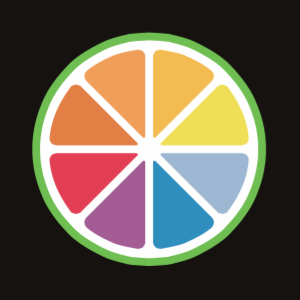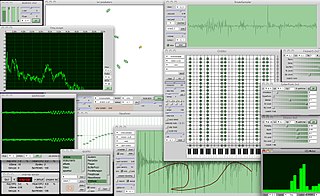
Qt is a free and open-source widget toolkit for creating graphical user interfaces as well as cross-platform applications that run on various software and hardware platforms such as Linux, Windows, macOS, Android or embedded systems with little or no change in the underlying codebase while still being a native application with native capabilities and speed. Qt is currently being developed by The Qt Company, a publicly listed company, and the Qt Project under open-source governance, involving individual developers and organizations working to advance Qt. Qt is available under both commercial licenses and open source GPL 2.0, GPL 3.0, and LGPL 3.0 licenses.
MLDonkey is an open-source, multi-protocol, peer-to-peer file sharing application that runs as a back-end server application on many platforms. It can be controlled through a user interface provided by one of many separate front-ends, including a Web interface, telnet interface and over a dozen native client programs.

wxWidgets is a widget toolkit and tools library for creating graphical user interfaces (GUIs) for cross-platform applications. wxWidgets enables a program's GUI code to compile and run on several computer platforms with minimal or no code changes. A wide choice of compilers and other tools to use with wxWidgets facilitates development of sophisticated applications. wxWidgets supports a comprehensive range of popular operating systems and graphical libraries, both proprietary and free, and is widely deployed in prominent organizations.
Open Sound Control (OSC) is a protocol for networking sound synthesizers, computers, and other multimedia devices for purposes such as musical performance or show control. OSC's advantages include interoperability, accuracy, flexibility and enhanced organization and documentation.
Virtual Studio Technology (VST) is an audio plug-in software interface that integrates software synthesizer and effects in digital audio workstations. VST and similar technologies use digital signal processing to simulate traditional recording studio hardware in software. Thousands of plugins exist, both commercial and freeware, and a large number of audio applications support VST under license from its creator, Steinberg.

Max, also known as Max/MSP/Jitter, is a visual programming language for music and multimedia developed and maintained by San Francisco-based software company Cycling '74. Over its more than thirty-year history, it has been used by composers, performers, software designers, researchers, and artists to create recordings, performances, and installations.

Fast Light Toolkit is a cross-platform widget library for graphical user interfaces (GUIs), developed by Bill Spitzak and others. Made to accommodate 3D graphics programming, it has an interface to OpenGL, but it is also suitable for general GUI programming.

GLib is a bundle of three low-level system libraries written in C and developed mainly by GNOME. GLib's code was separated from GTK, so it can be used by software other than GNOME and has been developed in parallel ever since.

New Interfaces for Musical Expression, also known as NIME, is an international conference dedicated to scientific research on the development of new technologies and their role in musical expression and artistic performance. Researchers and musicians from all over the world gather to share their knowledge and late-breaking work on new musical interface design.

The Yamaha Tenori-on is an electronic musical instrument designed and created by the Japanese artist Toshio Iwai and Yu Nishibori of the Music and Human Interface Group at the Yamaha Center for Advanced Sound Technology. It consists of a hand-held screen in which a sixteen-by-sixteen grid of LED switches are held within a magnesium plastic frame. Any of these switches may be activated in a number of different ways to create sounds. Two built-in speakers are located on the top of the frame, as well as a dial and buttons that control the type of sound and beats per minute produced.

The Reactable is an electronic musical instrument with a tabletop tangible user interface that was developed within the Music Technology Group at the Universitat Pompeu Fabra in Barcelona, Spain by Sergi Jordà, Marcos Alonso, Martin Kaltenbrunner and Günter Geiger.

JUCE is a partially open-source cross-platform C++ application framework, used for the development of desktop and mobile applications. JUCE is used in particular for its GUI and plug-ins libraries.

Impromptu is a Mac OS X programming environment for live coding. Impromptu is built around the Scheme language, which is a member of the Lisp family of languages. The source code of its core has been opened as the Extempore project.
Sergi Jordà is a Catalan innovator, installation artist, digital musician and Associate Professor at the Music Technology Group, Universitat Pompeu Fabra in Barcelona. He is best known for directing the team that invented the Reactable. He is also a trained Physicist.
Fluxus is a live coding environment for 3D graphics, music and games. It uses the programming language Racket to work with a games engine with built-in 3D graphics, physics simulation and sound synthesis. All programming is done on-the-fly, where the code editor appears on top of the graphics that the code is generating. It is an important reference for research and practice in exploratory programming, pedagogy, live performance and games programming.

Integra Live is open-source software for interactive sound design developed and maintained by the Integra Lab at Birmingham Conservatoire, part of Birmingham City University. The software takes an audio input either from the computer's audio interface or from an audio file, and allows various types of audio transformation to be applied. The software can be used in live performance as well as in creating new sounds or composing new music in a studio. Integra Live was originally designed to address problems of software usability in the creation and performance of live electronic music. Integra Live is supported on PC computers running the Microsoft Windows operating system and on Apple computers running OS X.













